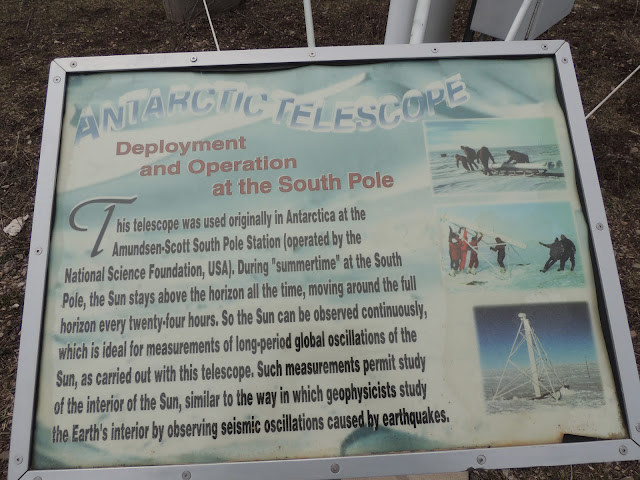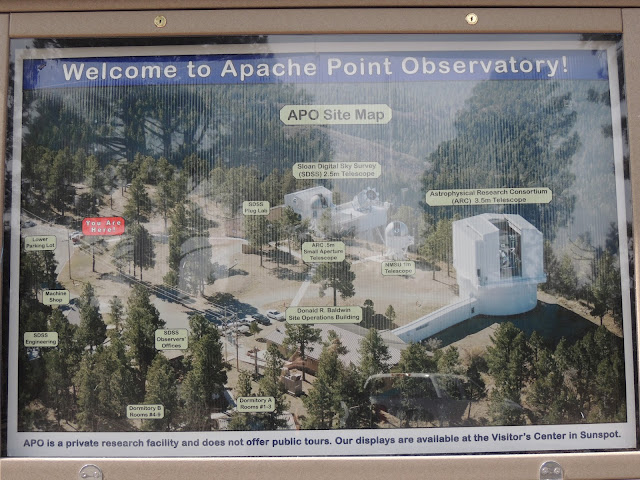March 16,2017
National Solar Observatory
Sunspot, NM
The Sunspot Scenic Bypass
There's a scenic drive to the Observatory through the Sacramento Mountains, through the Lincoln National Forest..
I Think the weather got to this sign.
The sign says, "The mountains and desert below create a bowl-like shape. You are standing on the rim. This bowl is known as the Tularosa Basin. The basin floor rests on rocks that have dropped seven thousand feet from their original position. The basin reaches 150 miles north to south and 60 miles east to west covering some 6500 square miles."
And here's a photo.
The white areas you'll see in these photos is the White Sands and Alkali flats from a previous post
Another weathered sign...
"The white sands in the distance are a unique feature in this area. The Sacramento and San Andres mountains provide gypsum crystals which wash down the mountains and accumulate within the Tularosa Basin. Wind breaks the crystals into tiny grains creating white sand."
First close up snow we've seen in over a year. I kinda miss it.
At the Peak
We had to walk a bit to get these photos.
We are here.
Neptune, Uranus, Saturn, Jupiter, Ceres, Mars, Earth, Venus, Mercury, and finally Sun.
I like to look at the stars and can identify the Big Dipper. That is the extent of my astronomy knowledge. I am fascinated with all things science, even if I know very little about a subject. I suggest these websites for the enquiring minds out there.
nsosp.nso.edu
www.nso.edu
Evans Solar Facility... Two telescopes observe the coronas and other activities.
The Dunn Solar Telescope... The building is 136 feet tall, but there is another 228 feet below ground. They can investigate granulation, sunspots, faculae, weak magnetic fields, filaments, and solar flares, using this telescope.
Oops Air????
Taken at the observatory grounds
The Hilltop Dome.. It's no longer used as an observatory, due to high costs of maintenance and advances in technology. It's being used as a design laboratory.
The Grain Bin Dome.
Necessity is the truly the mother of invention. This grain bin was purchased from Sears Roebuck and contained the first telescope at this site, while awaiting funding to build the observatory.
This armillary sphere and sundial was built by employees at the site.
The grounds are open, but not the buildings. For more details:
www.apo.nmsu.edu
www.arc.apo.nmsu.edu
www.cloudynights.com › Cloudy Nights › Observing › Solar Observing and Imaging
The Sloan Digital Sky Survey info can be found at:
http://sdss.org
This is the Highway number for the scenic drive....It's also the wavelength in Angstroms at which Hydrogen emits light.
On the road, we passed an old trestle and stopped to learn more about it.
These signs tell the story of the A&SMR (Alamogordo and Sacramento Mountain Railroad). It's a really cool story.
























































































No comments:
Post a Comment